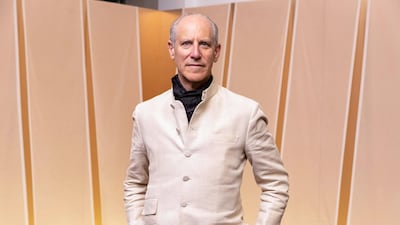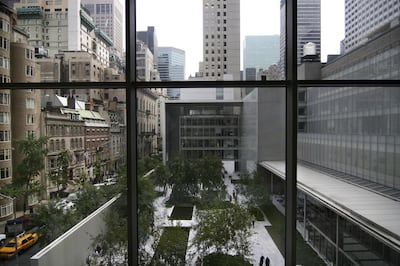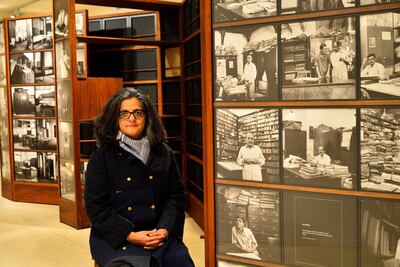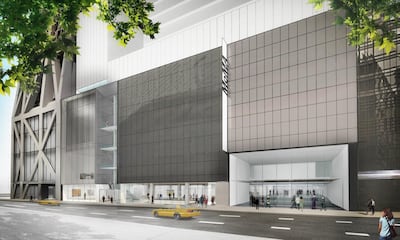For Glenn Lowry, the most exciting moment in Middle Eastern and UAE art … is right now.
It’s not an unsurprising statement given that a decade or so ago the contemporary art scene in the Emirates was light on the ground, and it’s grown exponentially since. But it is rather pertinent considering the man making that statement is at the helm of one of the world’s most prestigious art museums.
Lowry is the director of the Museum of Modern Art (Moma) in New York, and has been for 22 years. He's spent the past week taking in the wonders of Alserkal Avenue, the Sharjah Biennial and Louvre Abu Dhabi – each of which, he considers, stars in their own right.
"The biennial, since the early 2000s, has emerged as one of the great biennials in the world, but it's very artist-centric," he tells The National.
"I've been coming here for well over 10 to 15 years at this point – I watched Alserkal happen.
“But Abu Dhabi’s more about a major global museum that can operate like the Metropolitan in New York, like the British Museum in London.”
The UAE's growing art scene
There aren’t many people more well-versed in the intricacies of modern and contemporary art to make such a resounding statement. Lowry, by the time he retires, will have been at the forefront of New York’s contemporary art scene for three decades, and is now steering the museum through a $400 million (Dh1.46 billion) restoration and expansion project. So how could the likes of Louvre Abu Dhabi and the UAE’s burgeoning art scene possibly compare to that? “It’s the cultural ambition for the UAE and Abu Dhabi,” Lowry says.
“If you look at the Louvre, it’s been around for 200 plus years, and the Met for 150 plus years, so I don’t think you can just snap your fingers and create that, but I think that’s the ambition and so that’s a very different kind from the more granular approach of a place like Sharjah.
With the Guggenheim and the Zayed National Museum, as an infrastructure of major entities, it'll be quite fascinating and undoubtedly critically important to the region."
Lowry acknowledges the large number of Emirati visitors to Louvre Abu Dhabi as what will undoubtedly set it apart, as it isn't simply being marketed to tourists. He also pays tribute to the "visually stunning architecture", but he would say that, considering the same hands that sculpted Louvre Abu Dhabi will be sculpting Moma's new home. French architect Jean Nouvel's first New York skyscraper is the grandiose 53W53 tower, which sits beside the existing Moma building, and will house three levels of Moma's gallery spaces at its base when it opens in October.
"The intellectual agenda is a work in progress. What interests me is what that intellectual agenda ultimately looks like and how it will be different to a museum from New York or London or Paris. What will be the unique identity?"
The talented artists in the region
It's a question Lowry might just answer in his new book, which he lets slip during our chat. And in this one, the UAE looks set to get a starring role. "What's interesting is that within the past 30 years, the centre of cultural and artistic activity in the Middle East writ large has shifted from centres like Damascus, Baghdad and Cairo to the UAE for several reasons. The great wealth of the Gulf attracts artists and galleries, but also the destabilising politics of the heartland of the Middle East … has wreaked havoc. The UAE becomes a safe haven."
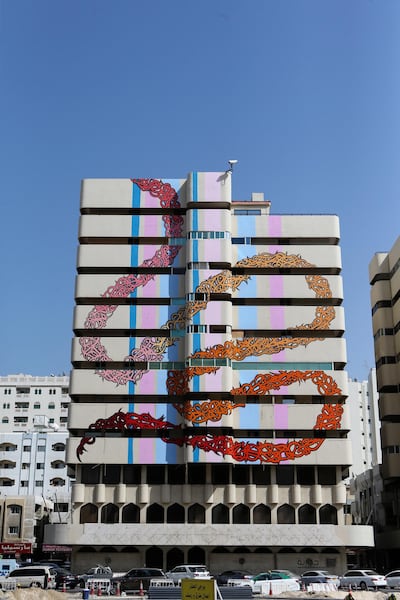
It's a point Lowry isn't making for the first time: he has long been at the heels of several of the region's biggest artists, snapping up their works in an attempt to show greater diversity throughout the halls of Moma. In fact, there's a "laundry list of amazing artists" he has watched grow over the years. They're some of many who have sought out the economic opportunity in the Emirates, he says, and the UAE's tolerant artistic practice has laid fertile ground for them to thrive.
The standouts are contemporary artist Manal Al Dowayan, originally from Saudi Arabia and, of course, eL Seed, "whose work is very different but who could operate from any number of places".
The list continues: Bangladeshi artist Dayanita Singh is a major figure in Moma’s collection, as is Jordanian artist Lawrence Abu Hamdan, who is also showing at the Sharjah Biennial. Then there’s Lebanese contemporary multimedia artist Walid Raad, and Sheela Gowda, from Bangalore. “We have been building the collection to show more image, to show more artists of colour, and to show more artists from different geographies,” Lowry says.
"We wanted to make sure their voices would be seen alongside the voices of Picasso and Pollock and those more familiar to American audiences. Take an artist such as Sheela Gowda or Dayanita Singh – giants in their world, and little-known in North America."
An interest in Islamic art
It’s a passion that runs deep for Lowry, having been “fascinated” with Islamic art since he pivoted away from becoming a doctor due to a distaste for primate biology. “This is in the blood for some reason. I can’t explain it other than it has been an enduring interest,” he says.
“I was encouraged to take courses in subjects I didn’t know anything about and ended up taking something in Islamic and Indian art with a brilliant and charismatic teacher and a lightbulb went off, and I never looked back.”
He went on to complete his PhD in Islamic art, and then became curator of Islamic Art at the Freer and Sackler Galleries in Washington DC, before becoming director of Moma when he was 40. He's set to be there for the next seven years, too. Moma last year changed its policies around retirement in order to keep Lowry until at least 2025, making him the longest-serving director since the museum opened 90 years ago. "So it would seem," he laughs, when faced with the fact that he'll be in his early seventies when he can finally put his feet up. "We're in a good place at the moment and if the shoe fits, keep it, I guess."
The drama with the Sackler family
It has been a tumultuous ride. As well as overseeing Moma's current overhaul (the renovation of 120,000 square feet of existing space, and the addition of about 45,000 square feet of gallery space), the visitor count has also rocketed from 1.6m to 3m a year under his charge. Most recently, Lowry has been weathering the same storm many others in the US's museum and art business have: the public outrage over donations by the Sackler family. It's especially poignant considering his previous employer bore the Sackler name.
The Sacklers own Purdue Pharma, a company that has made billions of dollars from the prescription painkiller OxyContin and has been accused of misleading the American public about the opioid's addictive qualities. They are also some of the foremost donors to art and museums in the US and Europe. "In the US, virtually all of our cultural institutions are privately supported. It depends on private philanthropy. It's a hard line to figure out," Lowry says.
“It seems so easy to say that the Sackler family has produced these drugs, they are being abused, they’ve been marketed in inappropriate ways and their money is tainted. I understand that argument, but I think it’s more complicated than that.”
This would herald a new age for the industry, Lowry believes, where institutions would come under heightened scrutiny over where their donations come from. It’s an audit he welcomes, so long as they’re “not collectively reckless”.
"One of the great philanthropic families is the Rockefeller family. One hundred years ago they were under terrible scrutiny for a range of activities that were considered deeply problematic. Today, they're held up as a model. How do we negotiate that?"
What's next?
For now, Lowry is spending all his energy readying his new spaces – one of the most exciting of which is a live performance space, affectionately dubbed "The Stack". It will be spread over the 4th and 5th floors of 53W53, and will champion emerging artists or historical pieces, and is largely the brainchild of Stuart Comer, Moma's chief curator of department of media and performance. "For a while, Moma was criticised for having lost its real commitment to contemporary art and that's emphatically not the case any more," Comer says.
One of those emerging artists is Reetu Sattar, a Bangladeshi creative who is part of the exhibition Fabric(ated) Fractures, at Concrete in Dubai. "In the context of Dubai, Moma has probably done more monographic shows than any other institution in the world, and that's a commitment we absolutely intend to continue," Comer says. "It's an exciting region to say the least."
Of course, Lowry agrees. "This is a fascinating place. What interests me is the UAE as an umbrella, and each of its constituent parts.
We're at a moment where there's a much greater recognition of understanding of what it means to be in the world, the idea that all you need is to know about what is happening in New York or Berlin or Paris is vaporised.
"But those were never the only places where art was being made."
